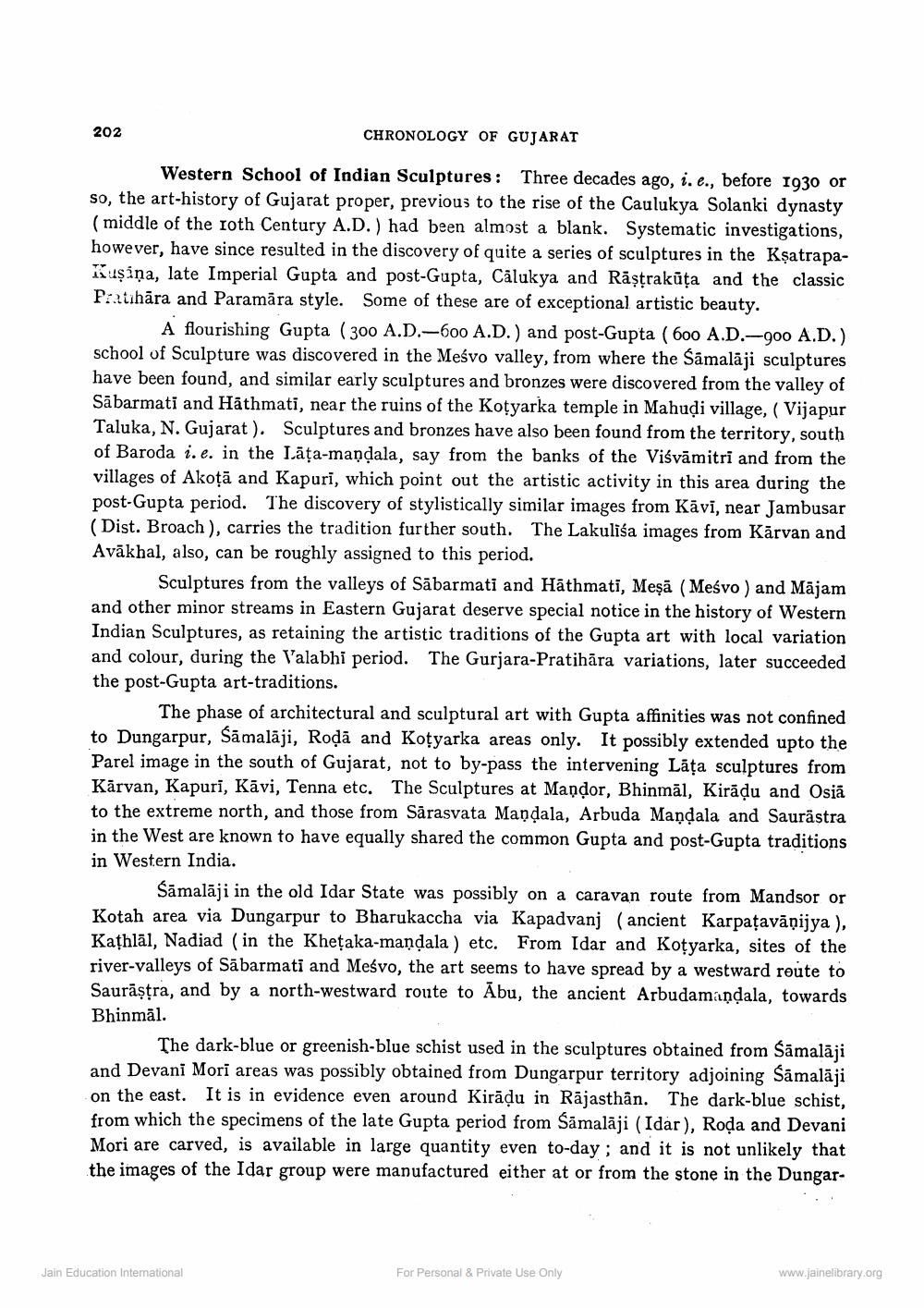________________
CHRONOLOGY OF GUJARAT
Western School of Indian Sculptures: Three decades ago, i. e., before 1930 or so, the art-history of Gujarat proper, previous to the rise of the Caulukya Solanki dynasty (middle of the roth Century A.D.) had been almost a blank. Systematic investigations, however, have since resulted in the discovery of quite a series of sculptures in the KsatrapaKusina, late Imperial Gupta and post-Gupta, Calukya and Rastrakūta and the classic. Pratihara and Paramāra style. Some of these are of exceptional artistic beauty.
202
A flourishing Gupta (300 A.D.-600 A.D.) and post-Gupta (600 A.D.-900 A.D.) school of Sculpture was discovered in the Meśvo valley, from where the Sâmalāji sculptures have been found, and similar early sculptures and bronzes were discovered from the valley of Sabarmati and Hathmati, near the ruins of the Kotyarka temple in Mahudi village, (Vijapur Taluka, N. Gujarat). Sculptures and bronzes have also been found from the territory, south of Baroda i.. in the Lata-mandala, say from the banks of the Viśvämitri and from the villages of Akota and Kapurl, which point out the artistic activity in this area during the post-Gupta period. The discovery of stylistically similar images from Kävi, near Jambusar (Dist. Broach), carries the tradition further south. The Lakuliša images from Kårvan and Avakhal, also, can be roughly assigned to this period.
Sculptures from the valleys of Sabarmati and Hathmati, Meşa (Meśvo) and Mājam and other minor streams in Eastern Gujarat deserve special notice in the history of Western Indian Sculptures, as retaining the artistic traditions of the Gupta art with local variation and colour, during the Valabhi period. The Gurjara-Pratihära variations, later succeeded. the post-Gupta art-traditions.
The phase of architectural and sculptural art with Gupta affinities was not confined to Dungarpur, Samalāji, Roḍā and Kotyarka areas only. It possibly extended upto the Parel image in the south of Gujarat, not to by-pass the intervening Lâța sculptures from Karvan, Kapuri, Kävi, Tenna etc. The Sculptures at Mandor, Bhinmal, Kirādu and Osia to the extreme north, and those from Sarasvata Mandala, Arbuda Mandala and Saurästra in the West are known to have equally shared the common Gupta and post-Gupta traditions in Western India.
Śāmalāji in the old Idar State was possibly on a caravan route from Mandsor or Kotah area via Dungarpur to Bharukaccha via Kapadvanj (ancient Karpatavānijya), Kathlal, Nadiad (in the Khetaka-mandala) etc. From Idar and Kotyarka, sites of the river-valleys of Sabarmati and Meśvo, the art seems to have spread by a westward route to Saurastra, and by a north-westward route to Abu, the ancient Arbudamandala, towards Bhinmal.
The dark-blue or greenish-blue schist used in the sculptures obtained from Samalāji and Devant Mori areas was possibly obtained from Dungarpur territory adjoining Sämalāji on the east. It is in evidence even around Kirādu in Rajasthan. The dark-blue schist, from which the specimens of the late Gupta period from Šāmalāji (Idar), Roda and Devani Mori are carved, is available in large quantity even to-day; and it is not unlikely that the images of the Idar group were manufactured either at or from the stone in the Dungar
Jain Education International
For Personal & Private Use Only
www.jainelibrary.org




